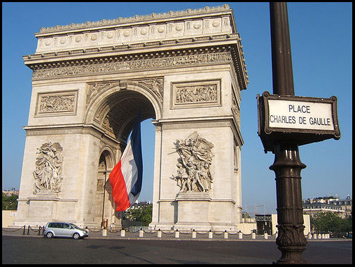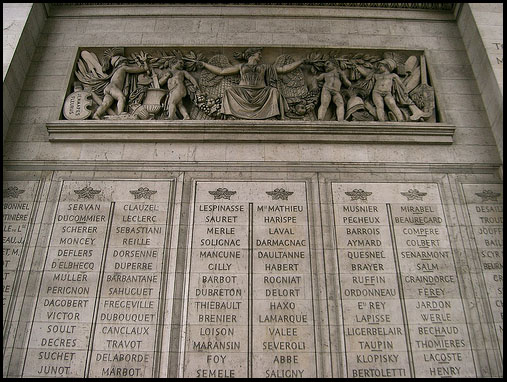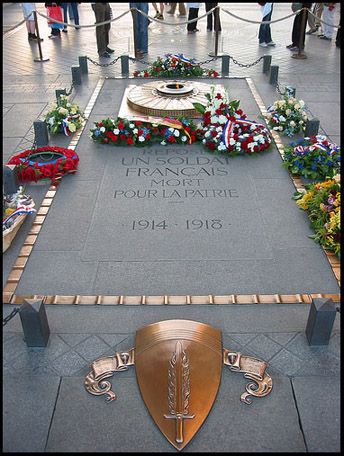
Photo by Brian Pennington
Ah, the Arc de Triomphe. A fantastic, world famous monument – and one of my favorites.
You’ll probably recognize it as being a landmark during the Tour de France, as the cyclists ride past it towards the finish line.
But this monument has seen a lot of history, and it is still very important to the French today. It is an image of national pride, and plays a key role in many of France’s important celebrations such as Bastille Day (July 14), and Armistice Day (November 11).
When to Go
Anytime is a good time to see the Arc de Triomphe – it is open almost everyday. The monument opens at 10:00 am and closes at 10:30 pm – from April to September it is open until 11:00 pm.
The monument is closed January 1, May 1, May 8, July 14, & December 25.
Try going more than once, if you have the time. The view of Paris from the top is spectacular. On a clear day you can see for miles, spotting many famous monuments. My favorite time to go is at night though. The Champs-Elysees glitters with lights and is truly a sight to see!
* The best time for photos is right when it opens, when the light is clearest, or right before sunset (my favorite photo-opportunity!)
Cost
It is free to wander around the base of the monument. There is a lot to see, like the many carvings and statues. Just be careful getting there! Be sure to use the underground passage. The roundabout here is legendary for its traffic – don’t risk running through it!
Tickets to explore the rooftop are €8,00 for adults and €5,00 for students ages 18-25 . The monument is free with a Paris Pass as well as for ages 17 and under.
History of the Arc de Triomphe
- Like many monuments, the history of the Arc de Triomphe is military. After his greatest victory in 1805, the Battle of Austerlitz, Napoléon promised his men they would “go home beneath triumphal arches”. The following year, he began building what was to become the most famous triumphal arch, as a memorial to the French Army.
- The Arc de Triomphe in Paris is definitely the most famous, but is one of many. Napolean had them built across the country as a symbol of his military power and French victory. Replicas can also be seen in Las Vegas and New York City.
- Napoléon originally concieved the Arc de Triomphe, but it wasn’t finished until 15 years after his death, in 1836. Although he was originally buried on St. Helena, in 1840 his remains passed under the arch en route to his tomb at Les Invalides. Since then, the arch has become a focal point for state funerals.
- The arch itself was designed by Jean Chalgrin (1739-1811), in the Neoclassical version of ancient Roman architecture. The arc is covered with reliefs, shields, and sculptures. The inside walls of the monument list the names of 558 French generals, underlining those who died in battle. Also inscribed are the names of the major battles of the Napoleonic wars.
- Famous victory marches past the Arc included the Germans in 1871, the French in 1918, the Germans in 1940, and the French and Allies in 1944 and 1945, and important celebrations still occur.

Photo by Edwin Lee

Photo by Eric Weigle
What to See
- The Tomb of the Unknown Soldier
- The Memorial Flame
- The walls and facade
- The view from the rooftop
On the walls of the Arc de Triomphe are many carvings and statues, including François Rude’s scultpture La Marseillaise, in which a winged figure of Liberty is calling the French to defend their nation.
There are also many names inscribed on the walls, of soldiers who gave their lives in the french army.
The Tomb of the Unknown Soldier lies underneath the Arc de Triomphe. It was installed on November 11, 1920, after World War I. An unknown soldier is buried under the Arc itself. The slab on top carries the inscription ici repose un soldat Français mort pour la patrie 1914 – 1918 (“Here lies a French soldier who died for his fatherland”).
The Memorial Flame is lit every evening, and burns in the memory of the dead never identified. It serves as a poignant tribute to the soldiers of World Wars I and II. A ceremony is held at the tomb daily at 6:30 pm (a very cool experience!)
The view from the rooftop of the Arc is fantastic, and provides a great view of Paris. It can be quite a trek up the stairs if the lift is out of order, since the monument stands 164 ft tall (50 m). (It’s the largest triumphal arch in the world!) Still, it’s worth the climb.
At the top, there is a museum with lithographs and photographs depicting the arch throughout its history, and a shop.
From the observation deck, you have an amazing panoramic view. You can admire the spoke-like street design, seeing the Place de la Concorde in one direction and the Grand Arch in the other. You can also see landmarks such as the Louvre, The Eiffel Tower, and Sacré-Cœur. At night, the city shimmers with lights – it’s a spectacular view!